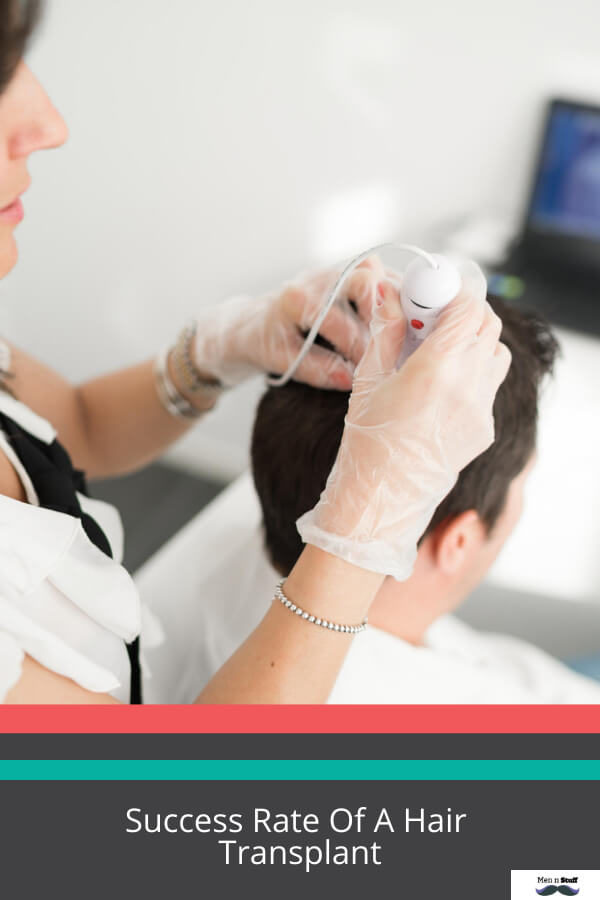The success rate of a hair transplant is very high, with around 95-98% of transplanted hair grafts surviving and growing new hair. This means that most people who undergo a hair transplant will see a significant improvement in their hair density and coverage.

What Is The Success Rate Of A Hair Transplant?
1. The Average Success Rate of Hair Transplants:
The success rate of hair transplants can vary widely, with figures generally ranging between 95-98%. It’s important to note that this degree of success often relates to the survival rate of the transplanted hairs during the first few months post-procedure.
2. Influencing Factors:
Several factors can influence the success rate of a hair transplant. This includes the skill and experience of the surgeon, the patient’s overall health, the quality of the donor’s hair, and the patient’s willingness to follow post-operative care instructions.
3. Surgeon’s Skill And Experience:
A hair transplant procedure is a delicate task that requires precision and expertise. The surgeon’s experience significantly influences the procedure’s success rate.
| Snapshot | Detail |
|---|---|
| Experienced Surgeon | High success rate, less damage to donor area, natural-looking results |
| Inexperienced Surgeon | Lower success rate, potential damage to donor area, unnatural results |
4. Health Condition of the Patient:
A patient’s overall health plays an essential role in the success of hair transplants. Patients in good health tend to have higher success rates than those with critical health conditions.
5. Quality of Donor Hair:
The quality and density of the donor hair can significantly influence the success rate. Patients with thick and dense hair typically achieve better results from hair transplantation than those with thin hair.
6. Post-operative Care:
Adherence to post-operative care instructions such as proper washing, avoiding exposure to sunlight, refraining from heavy exercises, and taking the prescribed medications, can positively impact the success rate of a hair transplant.
7. Type of Hair Transplant Procedure:
The type of hair transplant procedure can also affect the success rate. Procedures like FUE (Follicular Unit Extraction) and FUT (Follicular Unit Transplantation) have different success rates.
In conclusion, while the average success rate of hair transplants is quite high, a variety of factors can influence individual results. It’s essential for prospective patients to thoroughly research and consult with experienced professionals before deciding on a hair transplant procedure.
Why Are Hair Transplants Done?
Hair transplants are done for various reasons, primarily to address hair loss or balding. Here are detailed explanations of why people opt for hair transplants:
- Male Pattern Baldness: The most common reason is male pattern baldness (androgenetic alopecia), which leads to hair thinning and receding hairlines in men. Hair transplants can restore a fuller, natural-looking hairline.
- Female Pattern Baldness: Women also experience pattern baldness, though less frequently than men. Hair transplants can help women regain lost hair density.
- Alopecia Areata: Individuals with alopecia areata, an autoimmune condition causing hair loss in patches, may opt for hair transplants to fill in the affected areas.
- Scarring Alopecia: Scarring from injuries, surgeries, or skin conditions can result in permanent hair loss. Hair transplants can conceal or repair these scars.
- Hairline Refinement: Some people seek hair transplants for cosmetic purposes, such as adjusting or refining their natural hairline to achieve their desired appearance.
- Thickening Existing Hair: Hair transplants can add density and thickness to thinning but still existing hair, improving overall hair quality.
- Eyebrow and Eyelash Reconstruction: Hair transplant techniques can also be used to restore eyebrows and eyelashes for individuals who have lost them due to medical conditions, accidents, or over-plucking.
- Genetic Factors: Genetics can play a significant role in hair loss. Those with a family history of baldness may choose hair transplants to prevent or address their own hair loss.
- Psychological Well-being: Hair loss can negatively impact self-esteem and confidence. Hair transplants can improve psychological well-being by restoring a natural appearance.
- Hair Loss Due to Medical Treatments: Some medical treatments, such as chemotherapy, can lead to temporary hair loss. Hair transplants can be an option for regrowth once the medical treatment is complete.
- Reversing Previous Hair Restoration Procedures: In cases where older hair restoration methods were less effective or unnatural-looking, individuals may opt for newer transplant techniques to improve results.
- Personal Choice: Ultimately, some people choose hair transplants for personal reasons and aesthetics, desiring a specific hairstyle or a fuller head of hair.
Do Hair Transplants Work?
Hair transplants are generally more successful than over-the-counter hair restoration products. But there are still some factors to consider:
● All from 10 to 80 percent of transplanted hairTrusted Source will fully grow back in an estimated time of three to four months.
● Likewise, the regular hair, the transplanted hair will thin over time.
● People with the drowsing hair follicles (sacs that generally contain hair beneath the skin but no longer grow hair) might have less effective transplants. Yet, a 2016 study trusted Source suggests that plasma therapy could help up to 75 percent or even more of the transplanted hairs to grow back fully.
Although hair transplants do not work for everyone, they are predominantly used to restore hair as if you’re balding or thinning naturally or have lost your hair due to an injury.
Most of the transplants are done with your existing hair, so they are not as effective for treating people with:
● hair loss due to some medications or chemotherapy.
● Thick scars on the scalp from injuries.
● Widespread thinning and baldness.
How Much Do Hair Transplants Cost?
Hair transplants could range from about $4,000 to $15,000 per session.
Final costs might depend on the:
● the extent of the procedure of transplant.
● Availability of the surgeons in your area.
● Experience of the surgeon.
● Surgical techniques that are chosen.
Although hair transplants are cosmetic procedures, health insurance would not pay for the course.
Aftercare medications might also be added to the final cost.
How Does A Hair Transplant Work?
Directly in a hair transplant, surgeons take the hair you have on your scalp or some other part of your body and transfer it to an area where you do not have hair. It is typically taken from the back of your head but could also be taken from other parts of your body.
Before the start of a transplant, your surgeon would disinfect the area where the hair will be removed and would numb it with a local anesthetic. You could also request sedation to stay asleep while the procedure is being performed.
Then your surgeon performs one of two transplant methods: FUT or FUE.
Follicular Unit Transplantation (FUT)
FUT is occasionally known as follicular unit strip surgery (FUSS). To perform a FUT procedure, your surgeon would follow these steps:
● Using a scalpel, the surgeon removes a piece of your scalp, generally from the back of your head. The strip size usually is about 6 to 10 inches long but can also stretch from ear to ear.
● Then they close the area where the scalp was removed with stitches.
● The surgeon and his assistants would separate the scalp strip into smaller pieces with a scalpel. They might split the work up into as many as 2,000 smaller fragments that are known as grafts. Some of these grafts may only contain one hair each.
● Then by using a needle or blade, the surgeon makes tiny holes in your scalp where hair would be transplanted.
● Next, the surgeon inserts hairs from the removed piece of scalp into the puncture holes made before. This step is called grafting.
● They then cover the surgical sites with gauze or bandages.
The specific number of grafts you receive depends on the following:
● type of hair that you have.
● Size of the transplant site.
● quality, including the thickness of the hair
● hair color you have.
Follicular Unit Extraction (FUE)
To perform an FUE procedure, your surgeon follows these steps:
1. They shave off the hair on the back of your head.
2. Then the surgeon takes individual follicles out of the scalp skin. You will see tiny marks where each strand was removed.
3. According to the FUT procedure, the surgeon makes small holes inside your scalp and grafts hair follicles into the holes.
Afterward, they cover the surgical site with bandages or gauze.
Recovery
Both FUT and FUE each might take several hours to several days to complete the process of recovery. Whereas, this partially depends on the amount of work performed by the surgeon. You could go home on the same day as the procedure.
Once the surgery is performed, your surgeon carefully removes all bandages. The area might be swollen. Hence your surgeon might inject triamcinolone into that area to keep the swelling down.
You would likely feel soreness or pain at the transplant site and in the area where hair was taken from. For the next few days, your surgeon may also prescribe:
● pain killer medications, such as ibuprofen (Advil).
● Antibiotics to prevent infections.
● Anti-inflammatories, like an oral steroid, to have relief from swelling.
● Medications such as finasteride (Propecia) or minoxidil (Rogaine) would help to stimulate hair growth.
Some aftercare tips for hair transplant surgery are:
● Wait for a few days after the surgery to wash your hair. You could only use mild shampoos for the first few weeks.
● You should also be able to return to work or normal activities in about three days.
● Avoid pressing a brush or comb down over the new grafts for about three weeks.
● Do not wear any hats or pullover shirts and jackets until your doctor says it’s OK.
● Avoid exercising for about a week.
Which Factors Determine the Success Rate Of Hair Transplant?
The biggest concern is the success rate of hair transplants because everyone wants to ensure that they get permanent and natural outcomes after acquiring this transplant.
Is It Possible That You Could Need Another
Their doctor would tell some candidates that they might need multiple “sessions” of transplant surgery to achieve the results that they want.
Other candidates are pleased with the results after their first hair transplant has been performed and healed and later decide to fill out additional thinning patches on their heads.
Appearance
When your hair transplant procedure is done, it will take some time to see the visibility of the results. As soon as the transplanted sections of hair begin to heal, you may notice that you start to lose even more of your hair for the first few months. Your surgeon might have reassured you that this is normal and to be expected.
Once your hair transplant is fully healed, you will notice that the follicles of your hair will begin to make an appearance. The hair would grow in due course, be the same texture and length as the rest of your hair. Hair transplants performed by a micrograft could be dyed, styled, and cut according to your preference.
What To Expect Long-Term
Your hair transplant should be sustained over the long term. It is possible that as you age, the hair follicles will thin, but they will most likely produce at least some sort of hair for the rest of your life.
When To Talk To A Doctor
If you’re feeling self-conscious about your hair loss, you should speak with your doctor. There are some medical conditions and medications that could cause hair loss as a side effect. You might also need to rule out those outside factors before considering a candidate for a hair transplant.
Let’s See The Cost Before Seeking Consultation:
Cost Per Graft In US
| Cost per GRAFT | 1000 Grafts | 1500 Grafts | 2000 Grafts | 2500 Grafts | 3000 Grafts | 3500 Grafts | 4000 Grafts |
| $2.00 | $2,000 | $3,000 | $4,000 | $5,000 | $6,000 | $7,000 | $8,000 |
| $3.00 | $3,000 | $4,500 | $6,000 | $7,500 | $9,000 | $10,500 | $12,000 |
| $4.00 | $4,000 | $6,000 | $8,000 | $10,000 | $12,000 | $14,000 | $16,000 |
| $5.00 | $5,000 | $7,500 | $10,000 | $12,500 | $15,000 | $17,500 | $20,000 |
| $6.00 | $6,000 | $9,000 | $12,000 | $15,000 | $18,000 | $21,000 | $24,000 |
| $7.00 | $7,000 | $10,500 | $14,000 | $17,500 | $21,000 | $24,000 | $28,000 |
FAQs
1. What Causes A Hair Transplant To Fail?
2. What Is The Right Age To Get A Hair Transplant?
3. Are Follow-ups Needed After A Transplant?
References:
https://www.qunomedical.com/en/blog/hair-transplant-success-rates
https://www.estemedicalgroup.uk/blog/what-is-the-success-rate-of-a-hair-transplant

